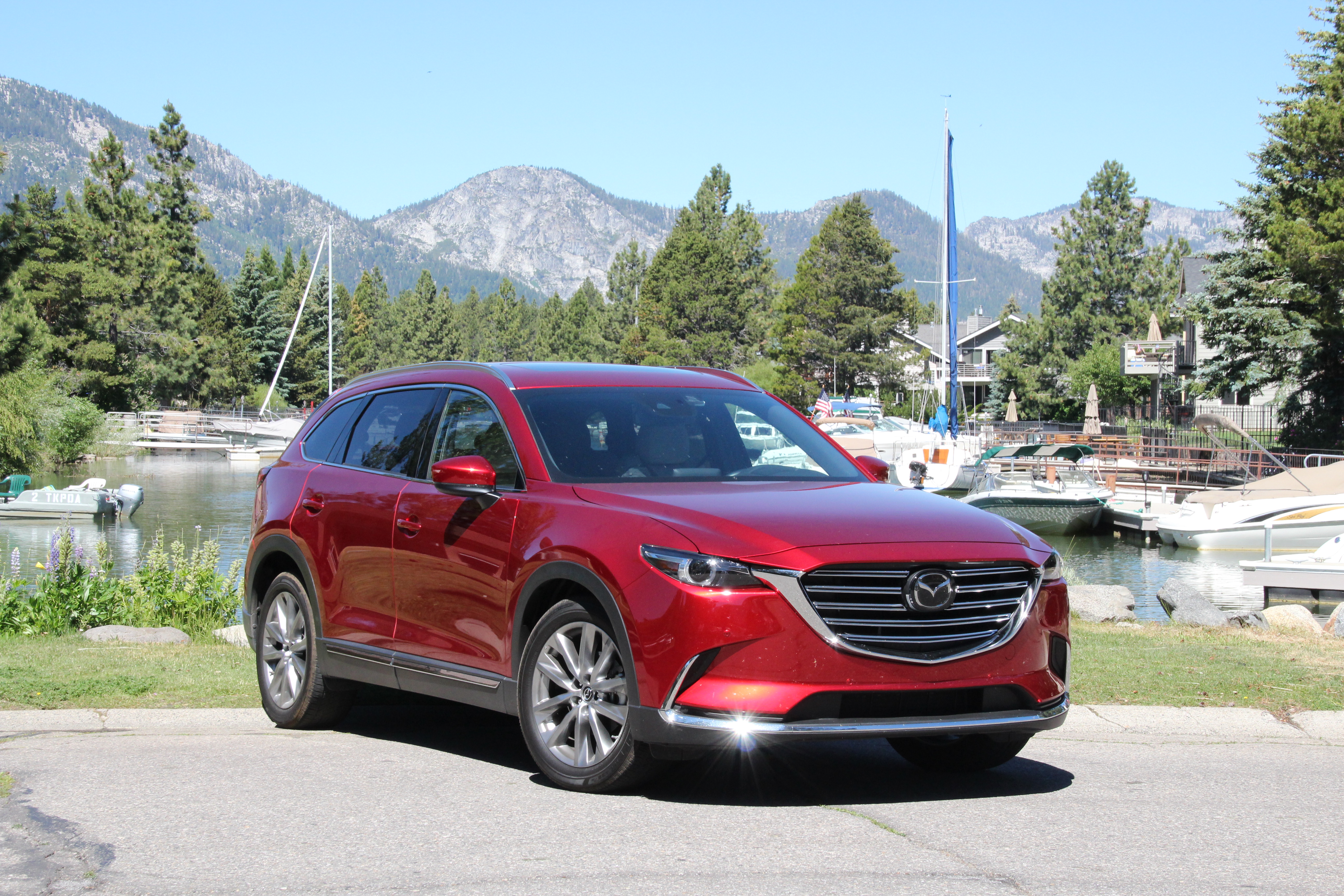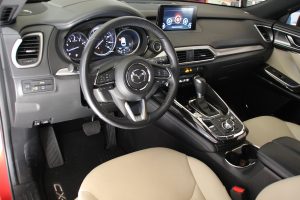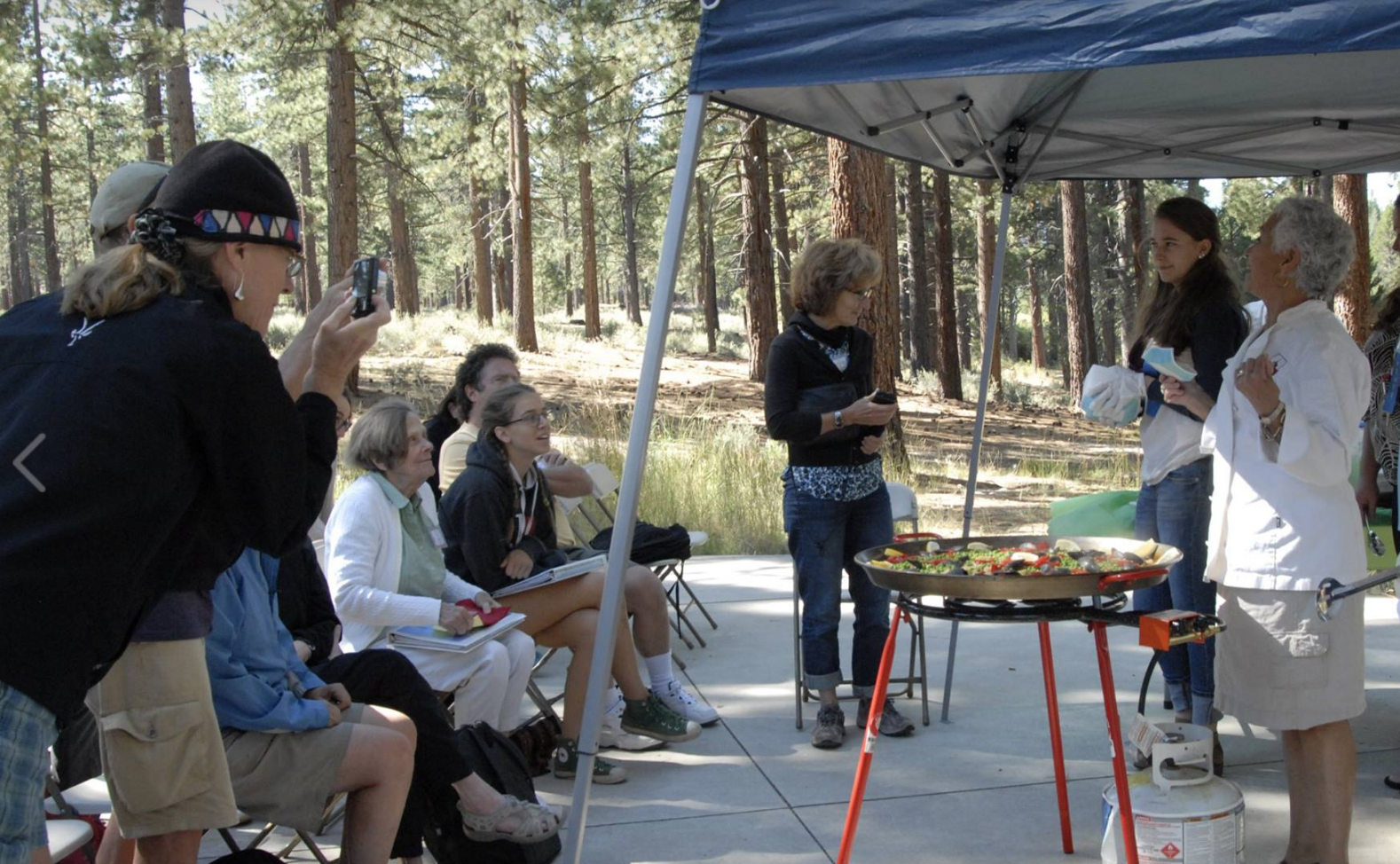Road Beat: Mazda CX-9 is a sporty SUV

The Mazda CX-9 is like an SUV sports car. Photos/Larry Weitzman
By Larry Weitzman
Now in its second model year, the 2018 Mazda CX-9 is a full-size SUV at 199-inches-long, a 115-inch wheelbase and almost 78-inches-wide. But it drives like a compact or mid-size SUV. Mazda creates this virtual illusion via a new for 2018 handling creation called G-Vectoring Control. It uses engine timing to control chassis dynamics, creating an imperceptible intervention which allows for more driver confidence and more control giving the driver the ability to make the CX-9 do exactly what he/she (or both) wants. It goes where you point it all with feeling (no numbness).
But it’s something that comes standard in every Mazda, a driver’s edge. Go to any race track and you will find more Mazdas than any other car, be it a Miata (the most raced car in the world), a Mazda 3 or an RX-7 or RX-8. You will find this edge or sharpness in every Mazda, and now the CX-9 delivers like a Miata when it comes to driving feel.
CX-9 is a beautiful vehicle. The first generation CX-9 was a stand out and the new gen follows in its path with the Kodo design philosophy emanating from the best front end in the business the Mazda grille. CX-9’s lines are beautifully flowing as like one of the two most beautiful airplanes ever to fly, the Supermarine Spitfire (the other is the P-51 Mustang). Mazda’s logo or emblem looks like a seagull in flight and legend has it that the designer of the Spitfire, R.J. Mitchell, used to watch and study seagulls flying in creating the eventual Spitfire design. Co-efficient of drag is a low 0.35.
Mazda didn’t stop with the design and G-Vectoring Control when it came to deigning the turbo charged direct injected (SkyActiv) 2.5L DOHC, 16 valve powerplant. Instead of using a twin-scroll turbo for quick spool-up, Mazda went one better (maybe two) by creating a Dynamic Pressure Turbo that through valving and port design smooths and evens out exhaust pressure pulses which especially helps improve turbo response at rpms below 1,500 rpm.

Specifications
Price $31,520 to about $45,000 for the Signature model
Engine
2.5L turbocharged DOHC, 16 valve direct injected inline four 250 hp @ 5,000 rpm
310 lb.-ft. of torque @ 2,000 rpm
Redline 6,300 rpm
Transmission
Six-speed torque converter automatic
Configuration
Transverse mounted front engine/FWD/AWD
Dimensions
Wheelbase 115.3 inches
Length 199.4 inches
Width 77.5 inches
Height 67.6 inches
Track (f/r) 65.3/65.2 inches
Ground clearance 8.8 inches
Weight (FWD/AWD) 4,054/4,307 pounds
GVWR (FWD/AWD) 5,661/5,816 pounds
Tow capacity 3,500 pounds
Steering lock to lock 3.1 turns
Turning circle 38.4 feet
Fuel capacity 19.5 gallons
Wheels 20X8.5 inches
Tires 255/50X20
Co-efficient of drag 0.35
Performance
0-60 mph 7.54 seconds
50-70 mph 3.98seconds
50-70 uphill (6-7 percent) 5.82 seconds
Top Speed Does anyone really care?
Fuel economy EPA rated (AWD) 20/26/23 mpg city/highway/combined. Expect 23 mpg in rural country and suburban driving and 28-29 mpg on a level highway at legal speeds.
Mazda’s 2.5L turbo creates 250 hp at just 5,000 rpm and a stump pulling 310 pounds of twist at just 2,000 rpm, but to achieve 250 hp premium fuel is required. Otherwise, if the computer senses 87 octane regular fuel it retards spark and peak hp to 227 at 5,000 rpm. Because the torque is so plentiful at low rpms, I didn’t really notice any difference and I doubt you will to unless you are tracking the CX-9 at Laguna Seca. Power is sent to all four wheels via a six-speed torque converter auto cog-swapper.
Performance is little hindered by its near 4,400 pounds of curb weight knocking off 0-60 mph in a quick 7.54 seconds. Acceleration builds with speed at 50-70 mph cones up in 3.98 seconds and the same run up a 6-7 percent grade only slows that time to 5.82 seconds. Throttle response is instantaneous once above 10 mph and grows with speed. It will take a few days to get used to the throttle as it is strong.
Fuel economy for my AWD tester is EPA rated at 20/26/23 and don’t expect much better. Highway mileage at a steady 70 mph is 28.6 mpg, but overall for 500 miles the CX-9 averaged 22.1 mpg. In my 200-mile round trip to Carson City it averaged 23.4 mpg in fairly aggressive driving. Mazdas are known for fuel economy as the company has held the highest CAFÉ in the industry. CX-9 is average in that category. Fuel capacity is a needed 19.5 gallons.
Handling is Mazda sharp, with sophisticated independent coil suspension all around and turned to perfection. Big meats (tires, 255/50X20) are mounted to beautiful 20X8.5-inch alloys so tenacious grip is standard. But the steering is a tad slow at 3.1 turns lock to lock albeit with good feel and accuracy. But with the G-Vectoring Control, it goes around corners like water in a hose communicating to the driver everything he needs to know when blasting the twisties. It is good.
Ride quality is extremely smooth and quiet. It absorbs bumps and other road imperfections with aplomb. Engine speed at 70 mph is 2,150 rpm in top or sixth gear. There is no wind, road or engine noise and I already told you that CX-9 is smoooooth and quiet.
Mazda is second to none in safety as my CX-9 Touring had it all with every acronym plus auto high beams, lane departure and lane keep assist and Smart Brake. LED adaptive front headlights were fabulous.
Inside is a Mazda leather interior which is sublimely comfortable, infinitely adjustable and super supple. Instrumentation is total with a heads-up display which now recognizes signage. There is even good room in the third-row seating. Now for the big negative, the sound system. Maybe it’s designed to improve your manual dexterity, but it requires too many steps and is much too complicated. Someone from a competitor must have designed it.
Cargo capacity is huge with over 71 cubic feet behind the first row, 38 cubes behind the second row and 14 cubes or about the volume of your average mid-size sedan trunk behind the third row.
Pricing starts at about $33,000 with shipping for the CX-9. My tester was a top of the line Grand Touring in incredible Soul Red Crystal ($595) stickering at $42,865 plus $940 for the boat from Japan. When you look at the competition, Mazda may offer a lot more SUV for a lot less money. This is a high performance near luxo ride for $43 large and some change. The are lesser equipped mid-size rides that cost that kind of dough. I am not sure if the bean counters had sabotaged adding machines but that seems like its too good a deal. I won’t say anything if you won’t.
Larry Weitzman has been into cars since he was 5 years old. At 8 he could recite from memory the hp of every car made in the U.S. He has put in thousands of laps on racetracks all over the Western United States.










